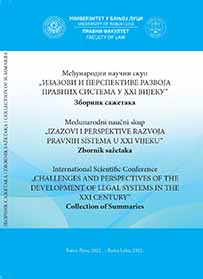
КО ЈЕ МОГАО БИТИ СВЕДОК У СРЕДЊОВЕКОВНОМ СРПСКОМ ПРАВУ?
Medieval Serbian regulations of domestic origin do not contain systematic norms about witnesses and testimony, but only a few incidental mentions. On the other hand, in the transplanted Rhomaian (Byzantine) collections - the Nomocanon (Zakonopravilo) of St. Sava and the Abbreviated Syntagma of Matthew Blastares, there are numerous regulations on how witnesses give statements and, even more, whose testimony is considered acceptable. Many years ago, Soloviev assessed that it was not necessary for Dušan’s Code to delve into this matter “because the numerous provisions of Byzantine law (...) exhausted the subject matter.” However, one must question how applicable these norms were in the law of medieval Serbia. Although judicial records have not been preserved, occasional mentions of testimony at assemblies or witnesses to the drafting of contracts can still provide us with a view of the practice. With a focus on those sources, this paper will try to show at least a partial picture of witnesses in medieval Serbian law. Special attention will be paid to the issue of women’s testimony.
More...





